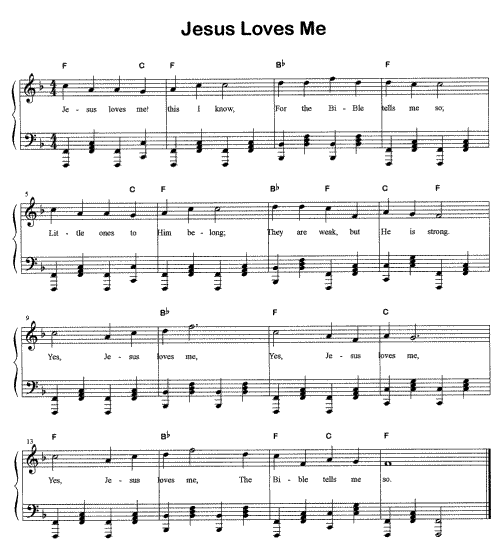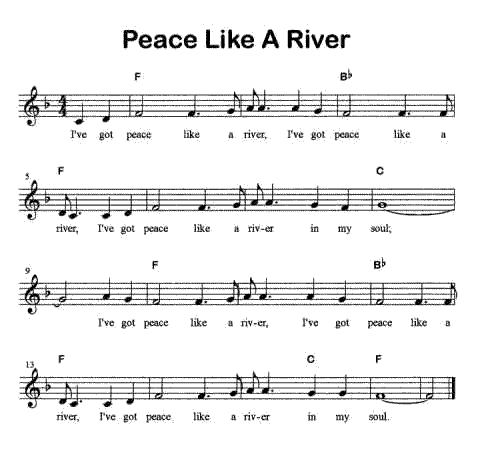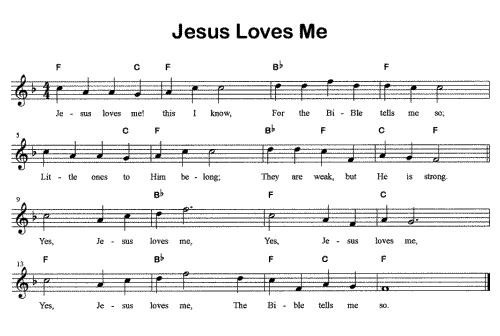Octave/Chord Introduction
The Octave/Chord Method is one of the hallmarks of the Evangelistic Style of piano playing. It is simple in its construction, and yet sophisticated in its application. It its different forms, it has been well utilized in classical music (most notably by Chopin) and has become a staple for the church pianist.
This is an overview of the Octave/Chord Method (hereafter referred to as the O/C Method) in its basic form, to be used as a basis for further learning and musicality.
Finger Numbers
First, we must get a few small (but important) details out of the way. One concept which we will refer to often is the idea of finger numbers. Using finger numbers, I can easily communicate to you which fingers should be used to play the written notes. The numbers of each finger are as follows: The thumb of each hand will be 1. Number your fingers outward, until you reach number 5, which will be your pinkies (See Picture Below). This method of numbering is universal, and used in all types of music.

The Hymn Player's Secret
One of the problems encountered when playing hymns is that there are a lot of notes in a small amount of space. If we could somehow simplify what we read (i.e., cheat), then it would be easier to play hymns, right? Well, here is how we can do just that. We are about to learn a pattern which your left hand will follow, while your right hand plays the melody. These next few paragraphs will be the basis for all of our evangelistic improvisation.
We will be using something called the Octave/Chord Method to play hymns. For our first example, we will begin with the C Major chord. If you are not that familiar with all of the different kinds chords, then please visit the chords tutorial here.
 |
| Fig. 1 |
Now for the Octave/Chord: First, use your left hand to play an octave C, as shown in Fig. 1. If you cannot reach an octave, than play the lower of the two C’s rather than playing the full octave. Most adults can reach an octave, but, because it does not feel natural, they avoid doing so. If you practice, however, you will soon find that it feels more "natural" to reach an octave than it does to reach a smaller interval!
 |
| Fig. 2 |
The second part of the Octave/Chord method is for you to move your left hand up an octave and play the C Major chord (Fig. 2). The notes of the C Major Chord are C, E, and G.
We will now alternate between these two positions. This is referred to as the 2/4 pattern (pronounced two-four). Try it a few times. Another pattern used is the 3/4 pattern (pronounced three-four). This is accomplished by playing the octave once, followed by the chord twice. This pattern will take three beats to complete. Fig. 3 shows you how the 2/4 and 3/4 O/C cycles looks when written on the music staff.
 |
| Fig. 3 |
| Listen to it |
From now on, we will refer to the phrase "Octave/Chord" as "O/C".
Play the O/C a few times. Speed is not that important! It is more important that you acquaint yourself with the feel of the O/C’s, and that you keep a steady beat. At first your hands will feel clumsy and your forearms will tire quickly because you are exercising muscles you do not normally use. Don't give up!
Playing O/C’s is the most difficult aspect of playing hymns, therefore do not expect to play them perfectly tomorrow... or the day after that... or next week. It takes time and practice for your hands to grow accustomed to the movement. You will make mistakes today, and you will make mistakes tomorrow. Just remember to play steadily, with the beat. If you play a wrong note, don't stop! Rather, keep playing and correct it the next cycle. When you are playing the piano for a congregation, almost no one, including other pianists, will know about your mistakes as long as you keep the beat going.
Pedaling
Pedaling is another technique that will aid your development as a hymn player. This makes use of the Sustain Pedal, the rightmost pedal at the base of the piano. The process of Pedaling is difficult to describe, but easy to do once learned.
Here is exactly how to use the pedal during the C Major O/C cycle:
- Play the octave C's (Fig. 1), and push down the sustain pedal.
- While still holding down the sustain pedal, move your right hand up and play a C Major chord (Fig. 2) for each remaining beat (Fig. 3).
- Begin the O/C cycle again, playing the octave C's.
- As you play the octave, release the sustain pedal, and press it again.
Fig. 4 is the same information in graphical form:
| 2/4 Pattern |
 |
| 3/4 Pattern |
 |
| Fig. 4 |
| Listen to the examples, with pedaling. |
Putting It Together: Mary Had A Little Lamb
Now we will play our first song. Here is the beginning of Mary Had a Little Lamb (Fig. 5) Remember: On the first beat, you play the octave. On beat two, you play the chord. Then you repeat the cycle for the rest of the beats. You may have noticed that Mary Had A Little Lamb is actually written in 4/4. To fill up the entire measure, we simply use the 2/4 pattern twice.
 |
| Fig. 5 |
What you will actually play is shown in Fig. 6. As you can see, even when the right hand is playing a half note (measure 2), the O/C cycle still continues. It may help you to think of your left hand as your metronome; it churns out a steady beat while your right hand plays the melody.
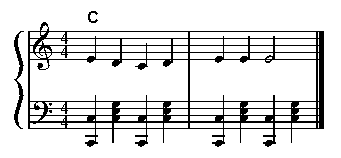 |
| Fig. 6 |
| Example: First two measures |
The G Major O/C
The two measures shown in Fig. 5 use an O/C cycle utilizing the C Major chord, which we have already learned. Now we will learn the O/C cycle using another chord: the G Major chord. Fig. 7 and Fig. 8 show us the G Major octave and chord, respectively.
 |
 |
| Fig. 7 | Fig. 8 |
As before, we must alternate between these two positions to complete the O/C pattern. You may have noticed that the C Major O/C and the G Major O/C feel the same to your left hand, which will make learning them easier. Practice those jumps!
Mary Had A Little Lamb
I believe it’s time for our first song to be completed. Let’s try Mary Had A Little Lamb in its entirety (Fig. 9). You will use both the C Major O/C and the G Major O/C in the 2/4 pattern. Look above each measure, and see what chord name is listed there. Play that O/C, and if there is no chord given, then play the chord from the previous measure. Have fun!
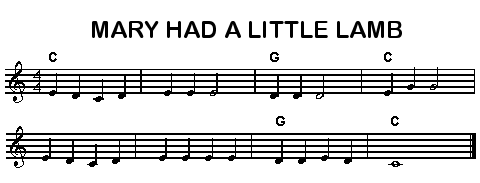 |
| Fig. 9 |
| Example: Mary Had A Little Lamb, complete |
Adding Another Chord: Jesus Loves Me
Another Chord: F Major
Now, let's add a few more songs to practice with. In order to do this, we must first begin to work with another chord, the F Major Chord. Fig. 10 and Fig. 11 show the F Major octave and chord, respectively. An important side point: It is impossible for me to describe where on the piano to play the O/C for each chord, so you need to figure that out on your own. Here is a good rule of thumb: If the chord sounds "muddy", then you are playing it too low. If the chord interferes with your right hand, then you are probably playing it too high. Just experiment to see which placement works best for you. |
Jesus Loves Me
Below is the children's song Jesus Loves Me. Try playing this song with the O/C before listening to the midi sample.
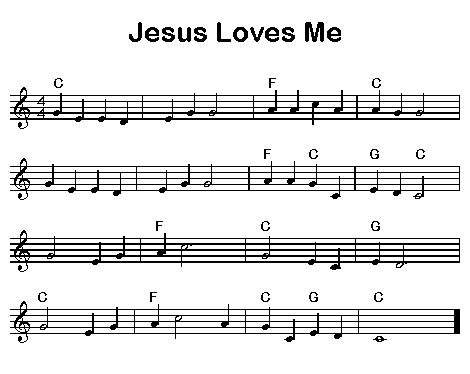
Remember to use the sustain petal to make your playing sound more fluid. In some places in the song, the chords change rather quickly, so watch out for those places and do not let the tempo slow down. Below is the same song written out with the O/C as it would be played. Please do not try to play from this version of the song; it is for reference only.
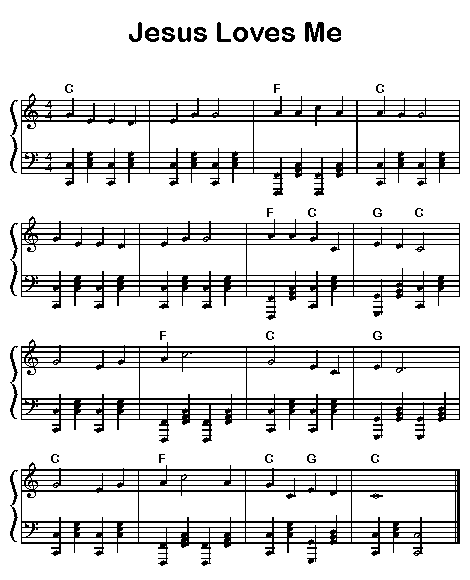
The B-I-B-L-E
Here is The B-I-B-L-E for you to play. Try to play it with O/C's before listening to the accompanying midi example. Notice that there is a pickup note at the beginning. You will not play anything with your left hand here. A good general rule is to wait until the first beat of the first full measure to begin playing the O/C.

Remember that you play the octave on beat one, and the chord on beat two. Even though this song uses eighth notes, this does not change our use of the O/C. Only play on the beats. Below is your reference for the above music. In the future, I cannot always provide this extra explanation, with the exception of a few troublesome spots we may come across.
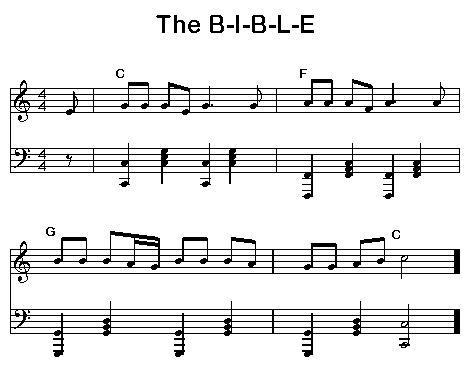
Peace Like A River
When playing Peace Like A River, remember not to play an octave and chord on the pickup measure. Also, watch out for the new key signature (F Major). If you need to, review chord construction here.
And, of course, here is what you just heard being played from the midi file.

Did you notice that the O/C remained constant throughout the selection, even during the tied notes? Often, because they do not know what to do with the extra time (beats), pianists will simply stop playing altogether, waiting for the singers to come back in for the next phrase. This produces an uncertainty in the music, causing the singers to feel insecure and sing softer. If, however, the accompanist plays with a steady beat, then there will be no confusion as to when to resume singing, the singers will sing with more confidence, and the song service will be that much better.
On a side note, remember that, if you click on the music, you can print out these samples and take them to your piano.
Shall We Gather At The River
Shall We Gather At The River presents us with a new challenge: the key of Eb. If this seems difficult at first, realize that two of the chords used (Eb and Ab) feel the same on the piano, making them easy to learn. Furthermore, we already know the third chord (Bb) from the previous song!
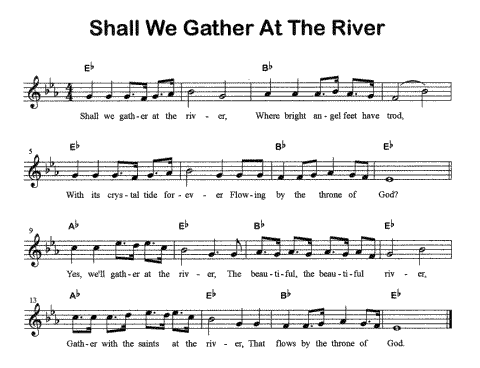
Example: Shall We Gather At The River
And, of course, here is the written out version of Shall We Gather At The River. Remember to sound happy when you play this song! Many people associate this song with funerals, because of every other song that hints at crossing a river when you die. This song is not about a river of death, but about the River of Life in Heaven! Begin trying to communicate that in your playing.
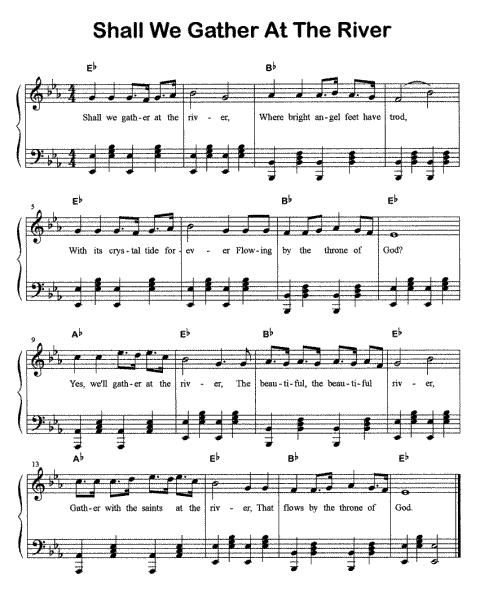
The Solid Rock
The Solid Rock is written in 3/4, but we cannot use a pure 3/4 O/C pattern to play it. Look at the example below, and see all of the chord changes which occur in the middle of the "normal" 3/4 O/C pattern.
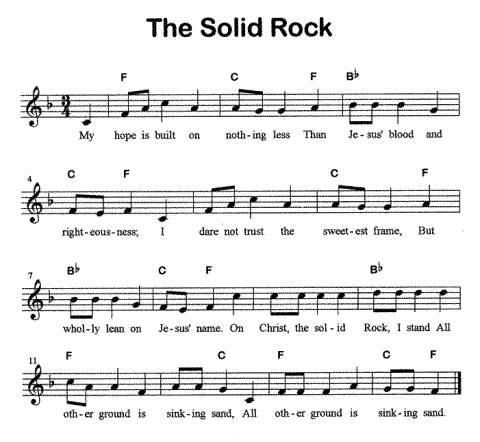
 |
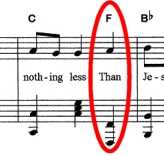 |
|
| Fig. 3 | Fig. 4 |
Fig. 3 shows the first situation in which a pure O/C will not suffice. In this measure, the Chord changes on the last beat of the measure, which is also the last beat of the O/C cycle. While we could just play an F Major chord on the third beat (which would match the necessary chord change), we choose to play an F Octave instead, which will give a firmness to the chord change. Fig. 4 Shows how this is implemented.
 |
 |
|
| Fig. 5 | Fig. 6 |
Look at Fig. 5. In this measure, the chord changes on the second beat of the measure, which is the second beat of the O/C cycle. Since we have two beats to fill with this new chord, we will play the new octave on the second beat, and the new chord on the third beat. Fig. 6 demonstrates this for us.
These two patterns occur several times each in this song. Look at the full example below if you have any trouble figuring out how to adapt the O/C for this song.
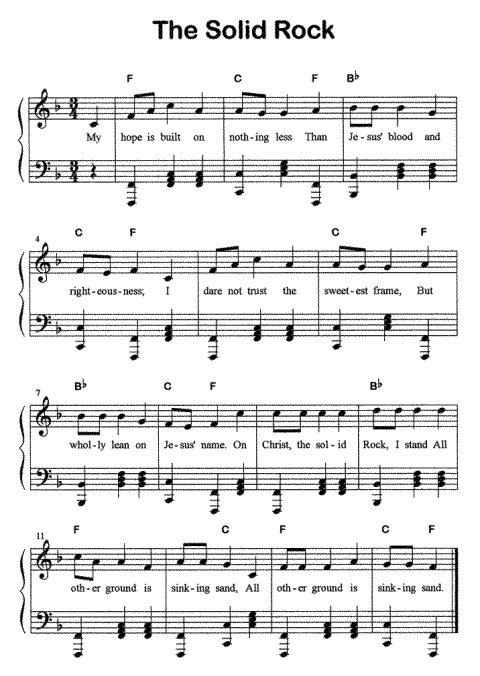
One final note concerning this song: Many churches will hold out certain notes in a hymn, even if it is not marked on the music. To further confuse things, no two churches do this on the same song, on the same note, for the same length of time. Some hymn publishers try to accommodate these traditions by adding fermatas and even changing the meter for one measure of the song. The best thing for the accompanist to do is to watch out for these situations, and improvise accordingly. In this song, we will simply add beats with our left hand where needed. Later, we will fill in with our right hand as well. Listen to the MIDI example below of The Solid Rock with a few "extra" beats thrown in.
Adapting the O/C To The Music: Jesus Loves Me
Up until now, we have seen how the O/C can enhance the music that we play. Music, however, does not always fit into this system perfectly. Many times, a chord is needed for only one beat instead of two or three. In this case, we modify the O/C to fit the situation.
Simply put, you should play the necessary O/C until a chord change occurs. When a change is needed, play the octave of the new chord, and, if there are any beats remaining in the original pattern which have not been played, use the new chord to play any remaining beats.
Jesus Loves Me
In this version of Jesus Loves Me, the chords sometimes change on the fourth beat of the measure. Since we are already familiar with the melody, we can put our attention to the necessary chording. Here is the music and the demonstration midi file.
 |
 |
|
| Fig. 1 | Fig. 2 |
Fig. 1 and Fig. 2 show how a change in the normal 2/4 O/C is reflected in your playing. Where one would normally play an F Major Chord on beat 4 (Fig. 1), instead you play an Octave C (Fig. 2). This is repeated again on the second line. While only a simple change, it does add a better harmony to the melody.
Here is the new version of Jesus Loves Me, as we would play it in our developing evangelistic style. Is it getting easier yet?
